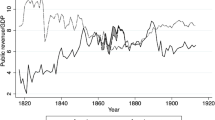Summary and conclusion
Using newly available data on comprehensive measures of U.S. and Soviet nuclear stockpiles this paper has investigated statistically the dynamics of nuclear arms acquisition by these nations over the past two decades. There is no evidence of a nuclear arms race between the United States and the Soviet Union.
On the contrary, there is clear evidence of Soviet ‘nuclear opportunism’ and American ‘nuclear drift’ over this period. During these decades the U.S. welfare system has expanded in two directions: into the federal budget, crowding-out defense, and into the private sector, reducing the untaxed taxable capacity of the nation. This process has rendered U.S. nuclear force levels unresponsive to changes in Soviet nuclear force, while allowing the Soviets to pursue political dominance through nuclear superiority as American ‘latent strength’ has declined. Estimates indicate that U.S. latent strength has lagged about one to five percentage points below that which would have forestalled further Soviet nuclear arms accumulation and stabilized relative force ratios. The SALT agreements appear to have hastened this process by facilitating an acceleration in the rate of increase of U.S. non-defense expenditures as a percent of GNP.
It is difficult to see how democracy and the West are to survive without a reallocation of resources towards defense. The analysis herein suggests, however, that restoring U.S./Soviet nuclear parity via a U.S. arms buildup, or a negotiated arms control agreement, will be difficult, if not impossible. With nuclear parity virtually unattainable, development of a strategic defense is of vital importance. Such a defense may allow us to escape from the rather ominous predicament into which we have drifted, ironically, in the pursuit of security.
Similar content being viewed by others
References
Committee on the Present Danger. (1984). Can America catch up? The U.S.-Soviet military balance. Washington, D.C.
Council of Economic Advisors. (Various years). Economic report of the President. Washington, D.C.
Friedman, M., and Friedman, R. (1984). Tyranny of the status quo. New York: Harcourt Brace Jovanovich.
International Institute for Strategic Studies. The military balance 1984–85. London.
Intriligator, M.D. (1975). Strategic considerations in the Richardson model of arms races. Journal of Political Economy 83 (April): 339–353.
Intriligator, M.D., and Brito, D.L. (1984). Can arms races lead to the outbreak of war? Journal of Conflict Resolution 28 (March): 63–84.
Jastrow, R. (1984). The war against ‘Star Wars’, Commentary 78 (December): 19–25.
Jastrow, R. et al. (1985). ‘Star Wars’ and the scientists: An exchange. Commentary 79 (March): 4–22.
Lehman, J.F., and Weiss, S. (1981). Beyond the SALT II failure. New York: Praeger.
McGuire, M. (1977). A quantitative study of the strategic arms race in the missile age. Review of economics and statistics 59 (August): 328–339.
Parkinson, C.N. (1960). The Law and the profits. Boston: Houghton Mifflin.
Richardson, L.F. (1960). Arms and insecurity. Chicago: Quadrangle Books.
Richelson, J.T. (1982). Static indicators and the ranking of strategic forces. Journal of Conflict Resolution 26 (June): 265–282.
Stockholm International Peace Research Institute. (Various years). World armaments and disarmament SIPRI yearbook. London: Taylor and Fancis.
Tullock, G. (1974). The social dilemma. Blacksburg, Va.: University Publications.
United States Department of Defense. (1984). Soviet military power. Washington, D.C.
United States Senate Armed Services Committee. (1984). Hearings: Department of defense authorization for appropriations for fiscal year 1985. Washington, D.C.
Weiss, S. (1984). The case against arms control. Commentary 78 (November): 19–23.
Wohlstetter, A. (1974a). Is there a strategic arms race? Foreign Policy 15 (Summer): 3–20.
Wohlstetter, S. (1974b). Rivals, But No Race, Foreign Policy 16 (Fall): 48–81.
Author information
Authors and Affiliations
Additional information
While retaining the responsibilities of authorship, I wish to thank Gordon Tullock, Robert J. Michaels, and participants in the CSUF Economics Workshop for valuable comments.
Rights and permissions
About this article
Cite this article
Ayanian, R. Nuclear consequences of the welfare state. Public Choice 49, 201–222 (1986). https://doi.org/10.1007/BF00127339
Issue Date:
DOI: https://doi.org/10.1007/BF00127339



